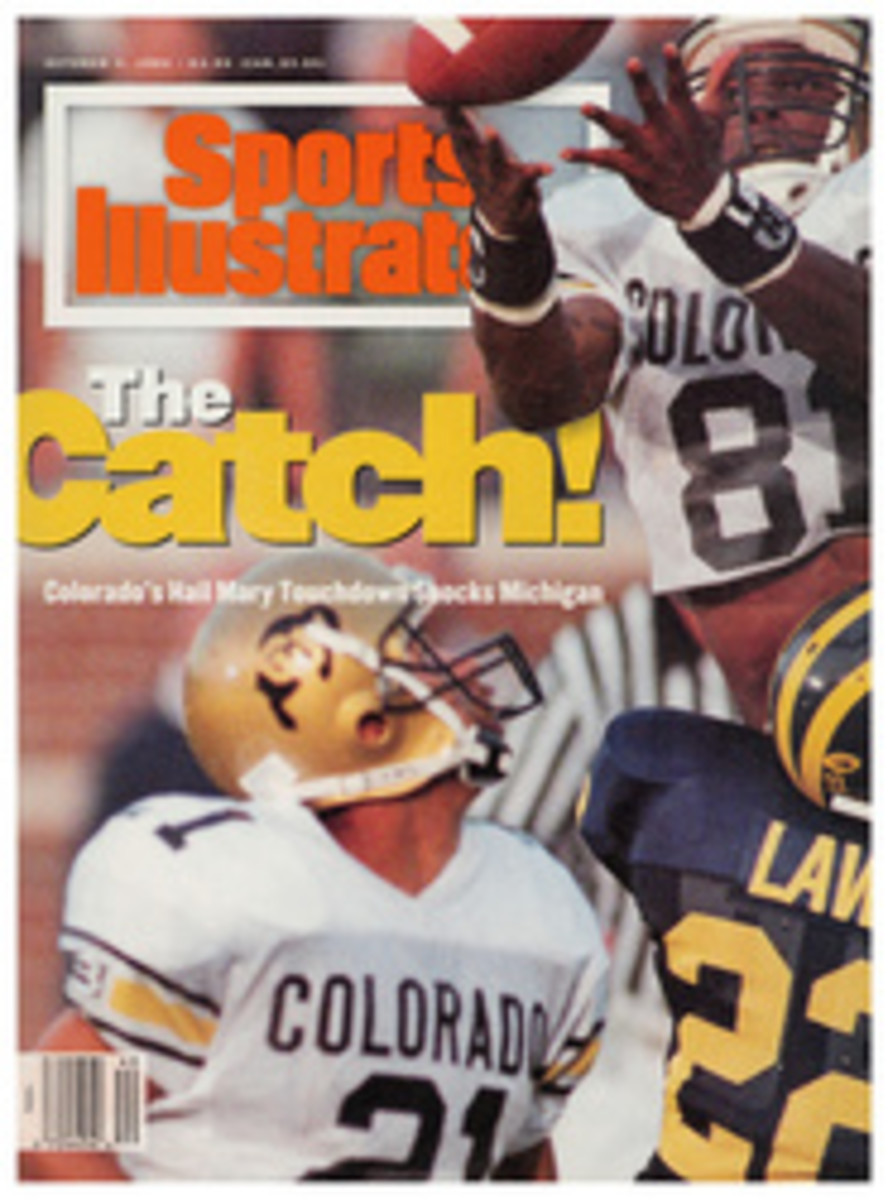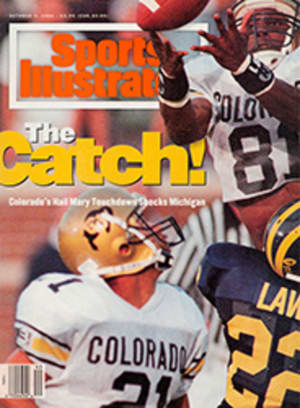
On, Brief Old Army Team!
The buses came to a stop, the band struck up a patriotic tune, and giggly cheerleaders from the local high school began performing a choreographed routine. Before a colorful autumnal backdrop provided by the Sharp Mountains, several dozen of the youngest students at John S. Clarke Elementary School in Pottsville, Pa., held yellow or blue balloons. All the children were wearing huge grins.
"The kids are so starry-eyed and excited," said Jack Spleen, a fourth-grade teacher at the school. "Quite a few of them couldn't even sleep the past few nights."
It was late October, and college football had come to this blue-collar town (pop. 18,000) 30 miles southwest of Jim Thorpe, Pa., and some 100 miles east of Joe Paterno. But it wasn't just college football. It was Army-Navy football, and the locals were putting on their best show.
Necks were strained and eyebrows raised as the citizens of Pottsville watched players step from the buses. The athletes were resplendent in their military uniforms: proud, disciplined, big, burly....
Cut! Wait a minute. Not big, not burly. These guys were college football players? The town had rolled out the red carpet for what appeared to be a busload of place-kickers, each hovering around 5'7" in cleats and weighing about 165 pounds soaking wet. Who had cast this scene? Mickey Rooney?
Welcome to lightweight football, which is the same as its heavyweight cousin in every way except that the combined weight of any two of its players equals that of some Big Ten linemen. That and the fact that players aren't recruited, games aren't scouted, fans are usually hard to come by, and the five schools that make up the Eastern Lightweight Football League (ELFL) field the only five teams in existence.
Army and Navy have won or shared 42 of the last 47 league titles. Since the two service academies all but own the Robert L. Cullen Trophy (named after longtime Cornell coach Bob Cullen, the Bear Bryant of the sport), they can boast of having the best lightweight football teams on earth. Some might say this is like claiming to be the world's tallest midget.
But to the residents of Pottsville, which hosts the annual Anthracite Bowl game between Army, most years, and another ELFL team, the lightweight players are larger than life. Says Spleen, "To the kids, seeing these athletes perform on the field is just as exciting as watching professional football players."
There are, however, more players in the NFL than in lightweight football. Only Cornell, Penn, Princeton and, of course, Army and Navy offer the sport. The game, in fact, is all but unknown outside these five schools, though it has been around for more than six decades.
The Eastern 150-Pound Football League, as it was first called, was founded in 1934 under the guidance of a Rutgers University athletic director named, appropriately, George Little. Seven schools joined the new league: Cornell, Lafayette, Pennsylvania, Princeton, Rutgers, Villanova and Yale. Early rules required that all players weigh no more than 150 pounds 48 hours before game time, a limit that has since been bumped up to 158 pounds. The result is still the same: a unique brand of football in which linemen are often faster than halfbacks and smaller than kickers.
"To me, it's like [being on] an all-star high school team," said Army linebacker James Lewis. "The caliber of play is good. Everybody is quick and hits hard."
A few of the players wouldn't hit 158 pounds if they stepped on a scale in their uniforms, but some of their teammates weigh as much as 165-170 pounds without gear. As the weigh-in approaches, they can be found sitting next to their friends on the wrestling team, sweating off excess pounds in the sauna. Said Paul Davis, a 5'5" defensive tackle for Navy who was able to combine his high school passions for football and wrestling, "I never imagined I'd be wearing a sweat suit, a hood and long Johns during football practice, trying to cut weight."
Lightweight players enjoy little of the celebrity bestowed upon the "big boys," as they call their heavyweight counterparts. They hope only for a chance to compete. "We had a couple of guys who actually tried out for the big boys and didn't make it," said Army safety Mike Long. "They were a little too small, maybe a little too slow. But they still have the heart to play the game of football."
Although a handful of the players starred in high school football, most were merely decent athletes who had abundant enthusiasm. "They may not have been the best athletes on their teams, but they got a lot of character and tough-guy awards," says Army coach Bob Thompson. His fullback John Fiorito gets closer to the point. "It's that short-guy Napoleon complex," he says. "We all have it." But how long will they have the opportunity to make use of it? Rutgers canceled lightweight football before the 1990 season, leaving the league—and thus the sport—on the brink of extinction, fighting to remain viable in an era of tight budgets and gender-equity pressures.
"It's scary to me, because I think only three schools are solid in the league—Cornell, Army and Navy," says former West Point athletic director Carl Ullrich, who played lightweight football at Cornell in the 1940s and finished a three-year stint as ELFL commissioner in 1992. "I think that if one more team drops out, the league could go down, and that would be a shame."
The disbanding of the league would certainly sadden the residents of Pottsville and southern Schuylkill County, Pa., for whom lightweight football has come to embody community pride and educational opportunity. The relationship between the sport and this anthracite mining town began 12 years ago when Bill Moran, a teacher at the elementary school, thought of inviting successful student-athletes to come to Pottsville for a game.
Historically, Pottsville has had a passion for football. The Pottsville Maroons, who joined the NFL in 1925 and played for three years, were one of the NFL's earliest franchises, and the Pottsville-Reading game is one of the oldest high school rivalries in the nation. When the town's Joint Veterans Council agreed to sponsor a lightweight football game, Army-Navy seemed to all like a natural choice.
Thus, on Nov. 12, 1983, the Anthracite Bowl was born. While Army's and Navy's big boys were preparing to head for balmy Pasadena for their annual meeting, their smaller counterparts took the field in Pottsville amid freezing rain and 32-mile-per-hour winds. "It just kept up all day," says Moran, "but you could still feel the warmth throughout the stadium because everybody was so proud. It was something special."
Army won that day 38-14, and it returned to Pottsville year after year, going undefeated (it played Princeton to a 25-25 tie in 1988) in the Anthracite Bowl until 1992, when it lost to Navy 31-14. That set the stage for last year's rematch.
What kept the Cadets coming back, however, was not only the competition but also the warm welcome in Pottsville. "We are not Pasadena," says Moran. "We don't have the glamorous industry or the tourism that some parts of the country have, but what we do have is people who open up their homes to strangers."
For one weekend each autumn, dozens of families serve as hosts for the athletes. (The ELFL recently decided to rotate participation in the bowl among the five schools; this year Navy will meet Princeton on Oct. 22.) These encounters often result in lasting friendships. "You usually stay with your hosts two or three years in a row, then after that you're still in contact with them through letters or visits," said Lewis. "For most of the guys on the team, it's like a second family."
For the parents and teachers of Pottsville, the Anthracite Bowl also provides a chance to help children recognize their own potential by introducing them to dozens of likely role models—dedicated athletes from prestigious schools.
Last year's celebration began on Friday, Oct. 22, with a trip by both teams to Good Samaritan Regional Medical Center to visit sick children and judge a hospital-wide decorating contest, followed by a kickoff luncheon and then a short bus ride to the elementary school. There the athletes signed autographs, answered questions and lectured students on the dangers of drugs and alcohol. They also participated in a pep rally featuring, among other things, a rendition of Anchors Aweigh by a fourth-grade Flutophone band.
Nearly 3,000 spectators filled Veteran's Memorial Stadium at Pottsville High on that Saturday as Army avenged the previous year's loss with a 28-3 triumph. Junior quarterback Mikell Harper ran for two touchdowns and passed for another, earning the MVP trophy, which he received that evening at an awards banquet attended by more than 500 residents of Pottsville.
The festivities, as always, came to an end on Sunday, with melancholy farewells and a chorus of come-back-soons. As the buses left Pottsville, a community that had looked forward to a weekend of friendship and football and a handful of players hoping for a warm reception were both contented. Small wonder.
TWO ILLUSTRATIONS
ROBERT ZIMMERMAN
Brad Herzog is a freelance journalist who lives in Chicago and writes often on sports.

